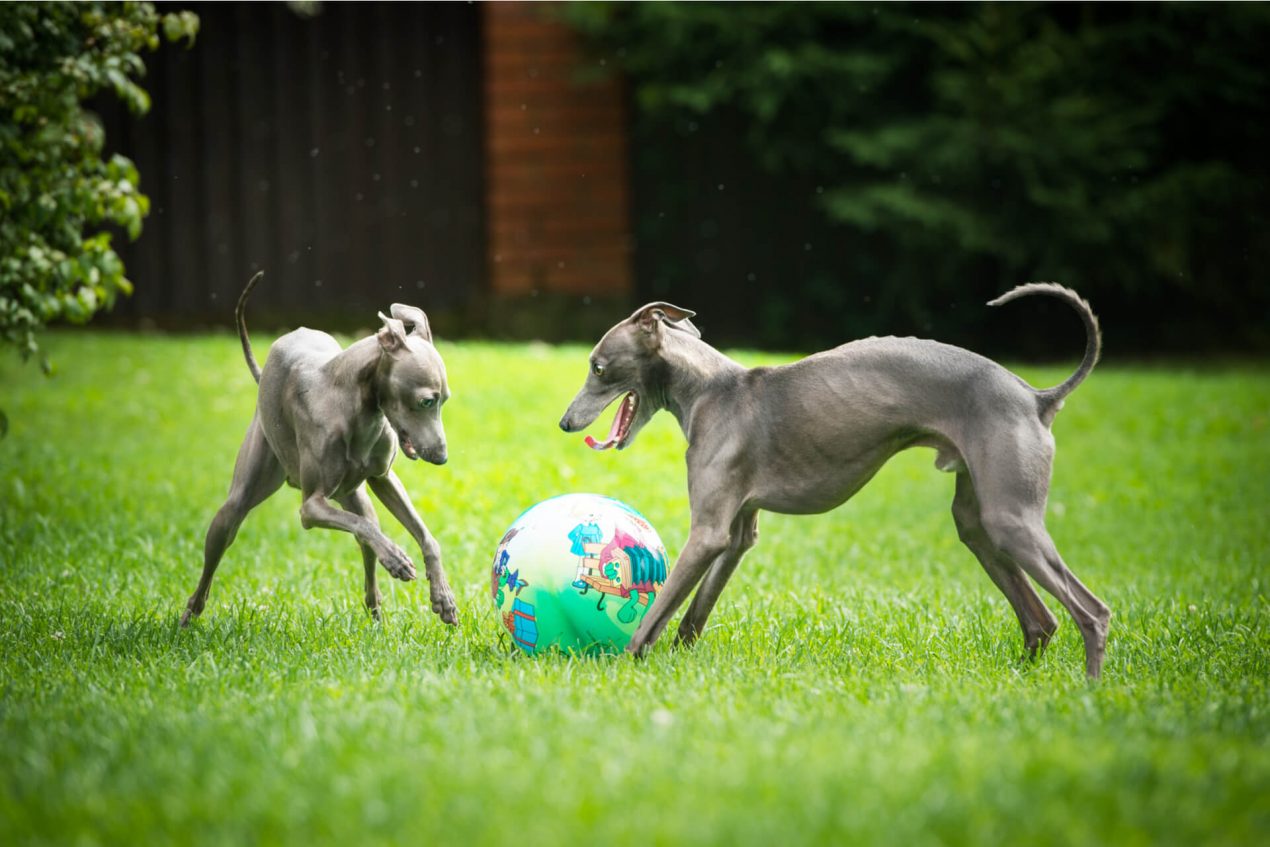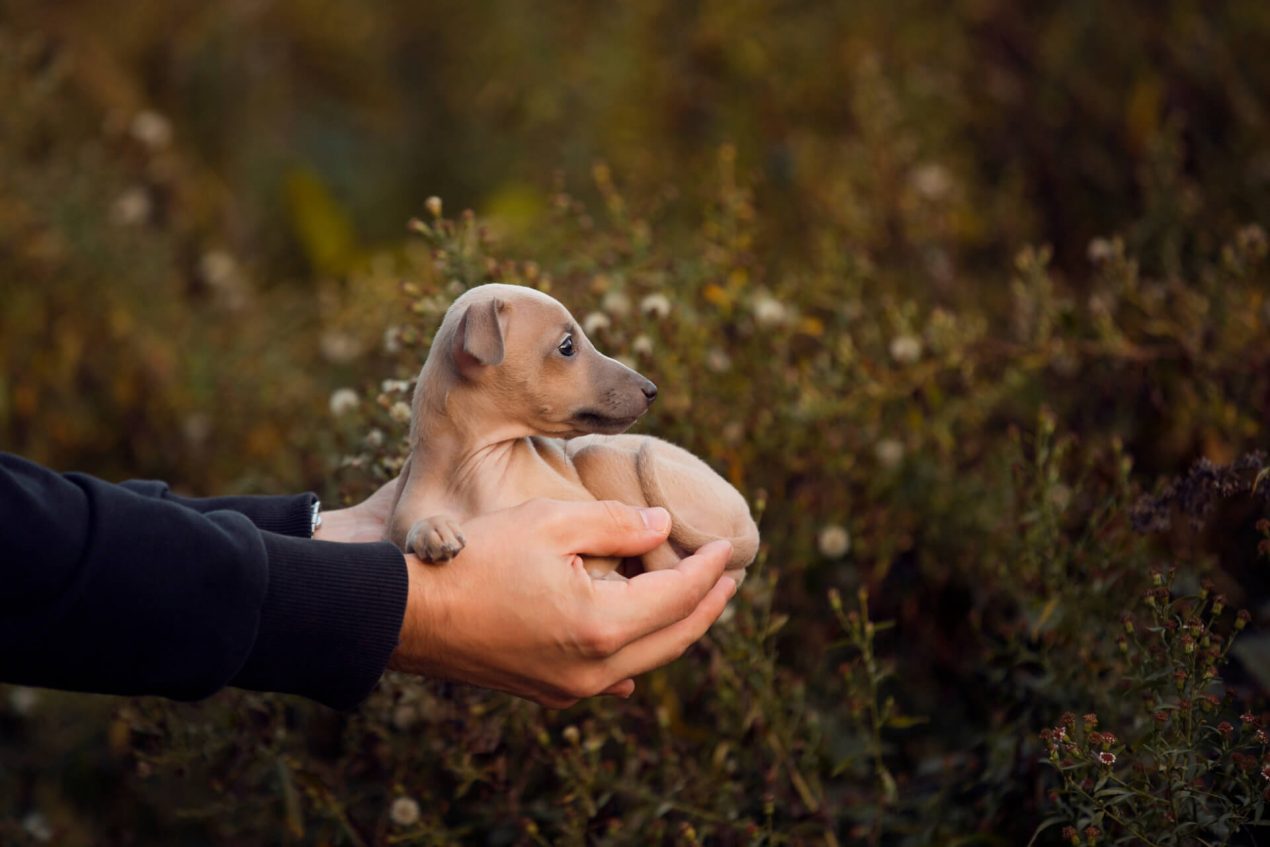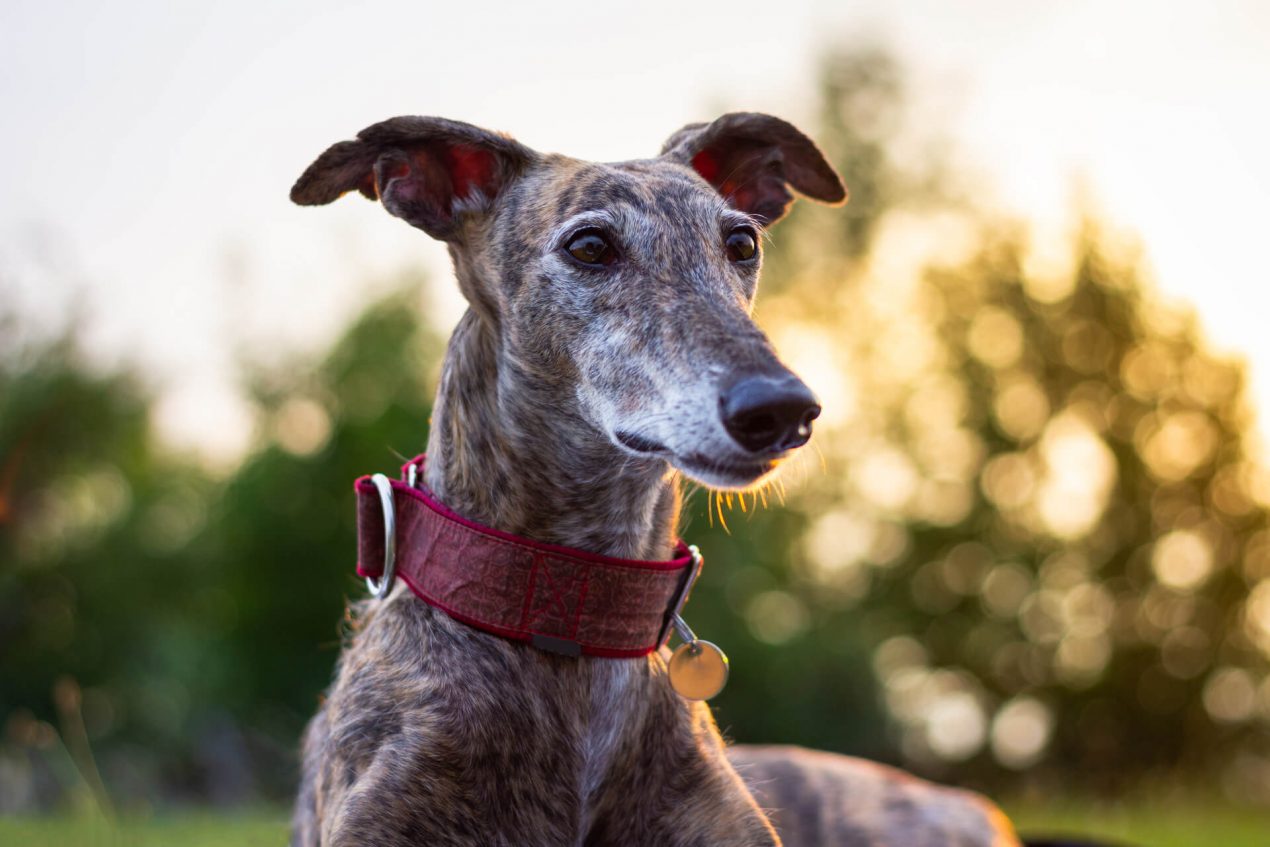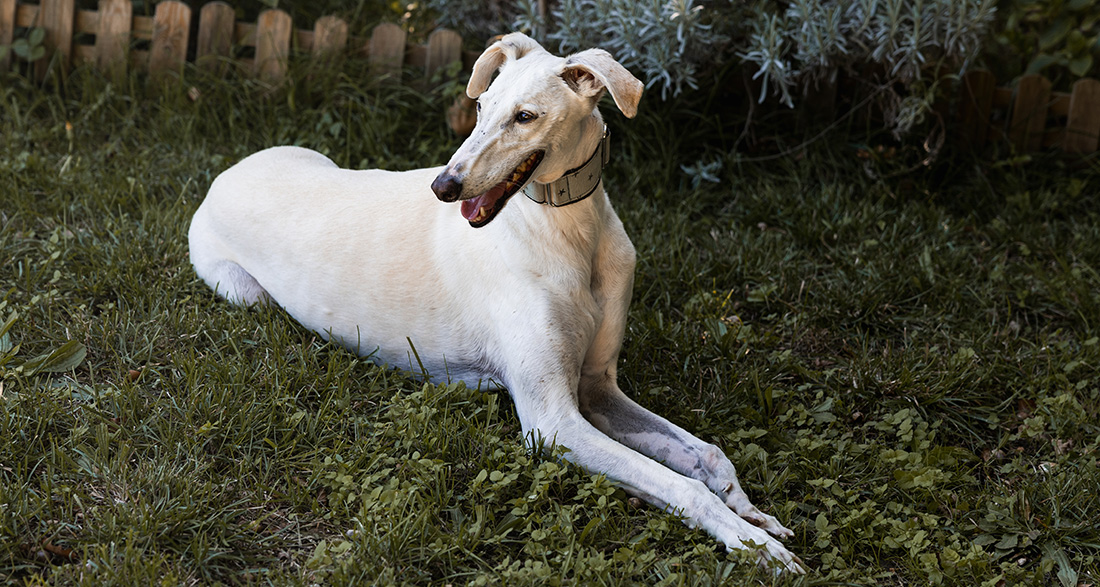The Greyhound is considered the fastest dog in the world and is regarded as the prototype of the sighthound. The long-legged, slender, and extremely fast animals have fascinated people throughout history.
However, the Greyhound is not only an excellent sprinter and hunting dog but also stands out with its friendly nature and adaptability. Originally used as a hunting dog, it has evolved into a beloved family member. In this article, we take you on a journey into the world of Greyhounds. Together, we explore their origin, characteristics, and provide valuable tips for care. Stay tuned and discover what makes this dog so special!
History of the Greyhound
As one of the oldest purebred dogs globally, the Greyhound has a long and fascinating history. Even today, we can admire depictions of Greyhounds on millennia-old tombs, coins, objects, and cave drawings. Scientists can trace the history of purebred dogs back to well before the birth of Christ, as in the Odyssey, Odysseus was recognized by a Greyhound after the Battle of Troy. Even the Pharaohs had Greyhounds as loyal companions.
The breeding history of the Greyhound can be traced back to the 4th century BCE. The dogs reached Great Britain through Celtic immigrants. In Britain, these dogs were reserved for the nobility, and King Canute of England even forbade regular citizens from interacting with Greyhounds. Over the centuries, the English nobility invested a considerable amount of time and effort in breeding hunting and coursing hounds. It wasn’t until the 16th century that wealthy non-noble English individuals were allowed to own and breed Greyhounds.
At that time, dog racing also emerged, initially taking place on open tracks and later in dedicated greyhound racing tracks. Greyhounds became a source of public entertainment, leading to a multibillion-dollar racing industry characterized by high betting stakes. This influenced breeding, and animals were selectively bred for speed, while those not performing well were euthanized.
Today, in most countries, dog racing and dog fighting are banned. In the case of Greyhounds, organizations have been established in many countries dedicated to preserving the breed. In breeding, the focus is now on the fantastic nature of the Greyhound, and in many countries, it is appreciated as a lovable and intelligent family dog.
Appearance of the Greyhound
Greyhounds are known for their slender build and impress with their speed, reaching speeds of up to 45 mph. Their bodies are slim and aerodynamic, with long legs and a narrow head. Their necks are long, and their chests are deep, aiding them in achieving high speeds.
They have a short, fine, and smooth, as well as dense coat. They come in various colors, including black, blue, fawn, and red. White, various brindle shades, and combinations are also possible. The Greyhounds eyes are expressive, showing remarkable attentiveness to their surroundings, a sign of their keen eyesight. Their hindquarters are muscular, contributing to their success in racing and sprinting. Their bodies are powerful and well-proportioned, exuding elegance and strength.
The withers height of Greyhounds is 68–71 cm, making them among the larger sighthounds. Males weigh about 27–40 kg, with females weighing about 6–10 kg less. They are dolichocephalic, meaning their skulls are relatively long, and their muzzles are elongated.
Greyhounds have an elegant appearance that reflects their athleticism. Their smoothness complements their form, making them fast and agile animals.
Breed Overview
GROUP: Hound
HEIGHT: Male 28 to 30 inches, female 27 to 28 inches
WEIGHT: 60 to 80 pounds
TEMPERAMENT: Even-tempered, intelligent, affectionate, athletic, quiet, gentle
COAT: Short and smooth
COAT COLOR: Black, blue, fawn, red, white, and various shades of brindle, or a combination of any of these colors
HYPOALLERGENIC: No
LIFE SPAN: 10 to 13 years
Nature and Character
The Greyhound is an impressive dog, capable of reaching speeds of up to 72 kilometers per hour with power and elegance. If you see them in action, it might be hard to believe that this swift runner can also relax on the sofa for hours. Behind the athletic facade is a calm and relaxed family dog who will delight you with adaptability and balance. Particularly on bike tours with the whole family, the Greyhound proves to be the perfect companion.
In everyday life, the Greyhound is a calm companion who scores points with its refined reserve. They are among the dogs that you can easily take with you to the office, shopping, to a restaurant, or a hotel. Aggressive behavior is entirely foreign to these noble purebred dogs. They rarely bark, making them pleasant companions. These easily trainable dogs show themselves to be loving and open playmates to both children and strangers. Their gentleness comes into play in all situations, making them likable and pleasant family members.
Despite their athletic abilities, Greyhounds are content to spend most of the day sleeping. They are intelligent, gentle, and have a calm disposition. Their behavior can be influenced by early experiences with people, other dogs and animals, as well as different environments. Sometimes they show a clownish side, but their independent nature could make play frustrating for children seeking constant interaction. In any case, the Greyhound offers a harmonious balance between activity and rest and adapts well to family life.
| Affection Level | High |
| Friendliness | High |
| Kid-Friendly | High |
| Pet-Friendly | High |
| Exercise Needs | High |
| Playfulness | High |
| Energy Level | Medium |
| Trainability | Medium |
| Intelligence | High |
| Tendency to Bark | Low |
| Amount of Shedding | Medium |

Acquiring a Greyhound
If you are considering getting a Greyhound, you should be aware that while they are calm cohabitants, they are also active animals with a deep passion for running and chasing. Accordingly, you should provide the Greyhound with a home with plenty of space. A large property where the Greyhound can run freely is ideal and makes the fast runner quite happy.
Moreover, you should offer the affectionate animal a loving home for its entire dog life. Especially due to its social nature, it is important for the Greyhound to be perceived as a full-fledged family member and fully integrated into family life.
What to Consider When Buying?
There are several things to consider when buying a Greyhound. Do you want to adopt a Greyhound puppy, or give a second chance to an adult Greyhound? The initiative “Greyhounds in Need” can help with that. Shelters also offer retired racing Greyhounds for adoption, and these dogs are hoping for a loving home.
If you want a puppy, choose a reputable breeder recognized by a breed club. Plan a visit to the breeder. Ensure that the dogs have family connections and are well-socialized. Observe the behavior of the parent animals. Ask to see the veterinary records of puppies and parent animals. A good breeder has the pedigree and other documents and will also answer questions about their animals. Questions about the care and maintenance of the dogs are also important.

Development and Training of the Puppy
Once you’ve chosen a Greyhound and a puppy joins your household, it’s crucial to start with their education and training immediately. Greyhounds are not only intelligent and eager to learn but also highly social. Therefore, it’s essential to focus on friendly and understanding communication. Remember that Greyhounds are very sensitive dogs with a strong urge to move and hunt. Thus, training and education require a great deal of sensitivity.
Gentle consistency is the key. Concentrate on teaching the puppy basic commands and socializing them well. This will help them adapt and become self-assured. Another crucial aspect is leash training. Due to their hunting instincts, Greyhounds should only run off-leash in nature if you are absolutely confident they can be reliably recalled. The stronger the trust and bond between you and the dog, the easier daily life will be with an adult Greyhound.
Basic education and socialization in the early years are vital to navigate smoothly through the challenging phases of growing dogs. It’s also important for them to encounter smaller animals in their early years, keeping their pronounced prey drive in mind. In a structured training environment, Greyhounds can thrive, and patience, consistency, and a deep understanding of the unique characteristics of this breed are essential.
How to Keep a Greyhound?
Keeping a Greyhound poses no problems as long as you ensure the dog can expend its energy and is adequately stimulated. If this is the case, you can experience an exemplary family and companion dog that adapts easily and remains calm and composed even in stressful situations.
Activities with the Greyhound:
Even though some Greyhounds may enjoy dozing for up to 16 hours a day, don’t forget that these active dogs have a true passion for running. Therefore, they need sufficient exercise to unleash their impressive speed and energy. While regular walks are certainly desired, they alone are not enough to meet their exercise needs. It is recommended to provide Greyhounds with 1 to 2 hours of exercise daily, with adults requiring 60-90 minutes of specific exercise time. Greyhound clubs can be a good resource, often providing secured racing tracks where these fast runners can pursue their passion and burn off energy.
Coursing is also a highly popular activity for Greyhounds. If you enjoy running or cycling, the Greyhound will be a reliable companion. In addition to daily walks and play sessions, regularly provide the Greyhound with the opportunity to romp in a secured area. While playing in the yard is acceptable, walks or visits to the dog park can be both mentally and physically stimulating for your four-legged friend. Even in a safe, fenced area, it’s important to monitor their activity to ensure their health and satisfaction.
Compatibility with Other Pets:
The compatibility of Greyhounds with other pets can vary depending on the temperament of the individual dog. While some Greyhounds get along well with other dogs and pets, they have a strong prey drive that can cause issues, especially with smaller animals. It is advisable to be cautious when your Greyhound interacts with smaller pets like cats or small dogs. Careful introduction and supervision are crucial to ensure the safety of all animals.

Health and Genetic Diseases
Greyhounds, especially racing Greyhounds, are robust and healthy animals when bred responsibly. If you choose such a dog, you’ll find that they generally have good health records. Breed-specific diseases are rare, especially if the breeding doesn’t involve former racing Greyhounds. Therefore, it’s essential for you to carefully examine the veterinary records of the parent animals.
Despite their robustness, Greyhounds can develop health problems. These include Greyhound myopathy, a genetic condition affecting the muscles, and anesthesia sensitivity, making Greyhounds more responsive to anesthesia. Therefore, inform your veterinarian if your Greyhound needs surgery. Another risk is bloat, a condition where the stomach twists and fills with gas, which can be life-threatening, especially in deep-chested breeds like the Greyhound.
Care of the Greyhound
Caring for a Greyhound is extremely straightforward and undemanding, provided you meet its need for running. Brush its short coat once a week to remove dead hair, and don’t neglect paw care. Especially in winter, it’s advisable to wash the paws with lukewarm water after a walk to prevent damage from road salt.
To promote a long and healthy dog life, it’s crucial to opt for high-quality food. Feeding a raw diet (barfing) is also a good option, but it’s important to gather information beforehand and seek advice from a knowledgeable veterinarian.
Due to their thin skin and short fur, Greyhounds tend to get cold quickly. Therefore, in colder months or climates, protective clothing such as coats or sweaters may be necessary to keep them warm. This clothing provides an additional insulation layer, keeping them warm and cozy. Additionally, providing a soft bed or mat is sensible to avoid skin irritations and pressure sores.
Interesting Facts
In 1914, Swedish immigrant Carl Eric Wickman started transporting miners to work with small buses. Over the years, the business evolved and expanded. In 1929, the Canadian Greyhound Coaches company was founded, which in 1940 merged into Greyhound USA and later became the Greyhound Corporation. The steadily growing network connected the United States, Canada, and Mexico, gaining worldwide recognition for the Greyhound Line. To this day, the company’s logo features the Greyhound purebred dog, symbolizing speed.
Do you also have a Greyhound or plan to get one in the future? Share what makes this breed special in the comments!


